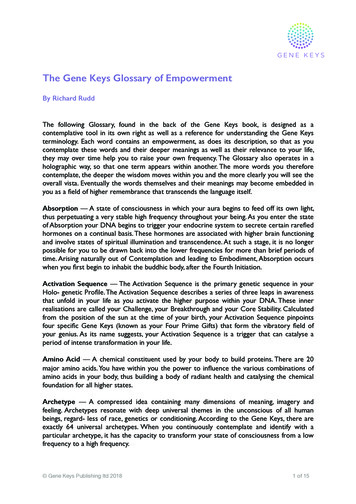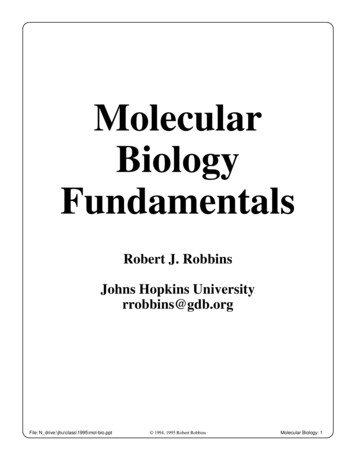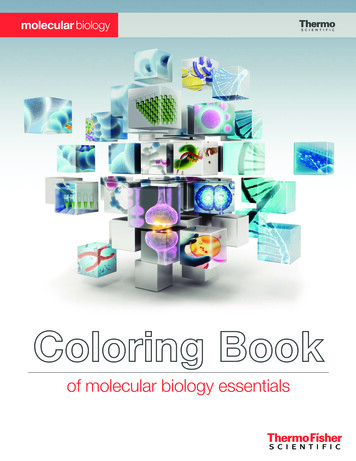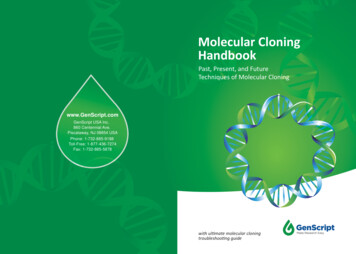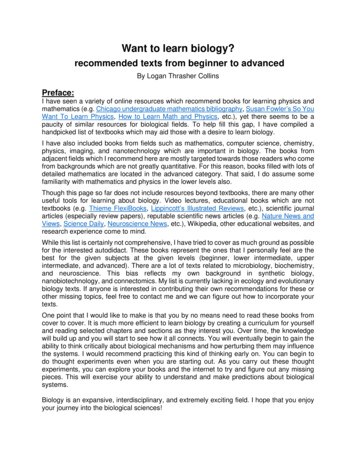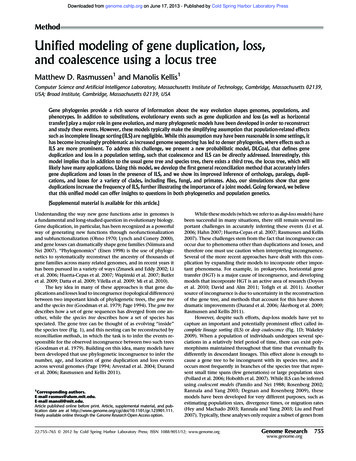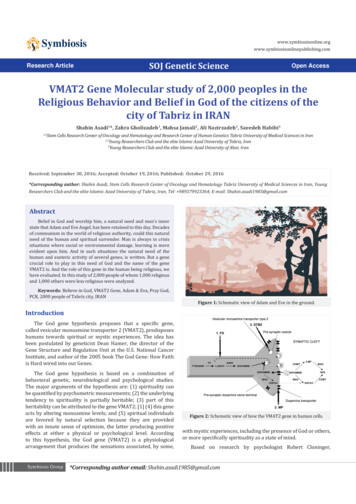
Transcription
SymbiosisResearch ArticleSOJ Genetic ublishing.comOpen AccessVMAT2 Gene Molecular study of 2,000 peoples in theReligious Behavior and Belief in God of the citizens of thecity of Tabriz in IRANShahin Asadi1*, Zahra Gholizadeh1, Mahsa Jamali2, Ali Nazirzadeh3, Saeedeh Habibi3Stem Cells Research Center of Oncology and Hematology and Research Center of Human Genetics Tabriz University of Medical Sciences in Iran1,2Young Researchers Club and the elite Islamic Azad University of Tabriz, Iran3Young Researchers Club and the elite Islamic Azad University of Ahar, Iran1,2Received: September 30, 2016; Accepted: October 19, 2016; Published: October 29, 2016*Corresponding author: Shahin Asadi, Stem Cells Research Center of Oncology and Hematology Tabriz University of Medical Sciences in Iran, YoungResearchers Club and the elite Islamic Azad University of Tabriz, Iran, Tel: 989379923364; E-mail: Shahin.asadi1985@gmail.comAbstractBelief in God and worship him, a natural need and man’s innerstate that Adam and Eve Angel, has been retained to this day. Decadesof communism in the world of religious authority, could this naturalneed of the human and spiritual surrender. Man is always in crisissituations where social or environmental damage, learning is moreevident upon him. And in such situations the natural need of thehuman and esoteric activity of several genes, is written. But a genecrucial role to play in this need of God and the name of the geneVMAT2 is. And the role of this gene in the human being religious, wehave evaluated. In this study of 2,000 people of whom 1,000 religiousand 1,000 others were less religious were analyzed.Keywords: Believe in God, VMAT2 Gene, Adam & Eva, Pray God,PCR, 2000 people of Tabriz city, IRANIntroductionFigure 1: Schematic view of Adam and Eve in the ground.The God gene hypothesis proposes that a specific gene,called vesicular monoamine transporter 2 (VMAT2), predisposeshumans towards spiritual or mystic experiences. The idea hasbeen postulated by geneticist Dean Hamer, the director of theGene Structure and Regulation Unit at the U.S. National CancerInstitute, and author of the 2005 book The God Gene: How Faithis Hard wired into our Genes.The God gene hypothesis is based on a combination ofbehavioral genetic, neurobiological and psychological studies.The major arguments of the hypothesis are: (1) spirituality canbe quantified by psychometric measurements; (2) the underlyingtendency to spirituality is partially heritable; (3) part of thisheritability can be attributed to the gene VMAT2; [1] (4) this geneacts by altering monoamine levels; and (5) spiritual individualsare favored by natural selection because they are providedwith an innate sense of optimism, the latter producing positiveeffects at either a physical or psychological level. Accordingto this hypothesis, the God gene (VMAT2) is a physiologicalarrangement that produces the sensations associated, by some,Symbiosis GroupFigure 2: Schematic view of how the VMAT2 gene in human cells.with mystic experiences, including the presence of God or others,or more specifically spirituality as a state of mind.Based on research by psychologist Robert Cloninger,*Corresponding author email: Shahin.asadi1985@gmail.com
VMAT2 Gene Molecular study of 2,000 peoples in the Religious Behavior and Belief in Godof the citizens of the city of Tabriz in IRANCopyright: 2016 Asadi, et al.this tendency toward spirituality is quantified by the selftranscendence scale, which is composed of three sub-sets: “selfforgetfulness” (as in the tendency to become totally absorbed insome activity, such as reading); “transpersonal identification” (afeeling of connectedness to a larger universe); and “mysticism”(an openness to believe things that remain unproven, such as ESP)(This is an incorrect definition of mysticism). Cloninger suggeststhat taken together, these measurements are a reasonable wayto quantify (make measurable) how spiritual someone is feeling.The self-transcendence measure was shown to be heritableby classical twin studies conducted by Lindon Eaves and NicholasMartin. Interpreters of these studies argue that specific religiousbeliefs (such as belief in Jesus) have no genetic basis and areinstead memes,[citation needed] cultural units transmitted byimitation (non genetic means).In order to identify some of the specific genes involved inself-transcendence, Hamer analyzed DNA and personality scoredata from over 1000 individuals and identified one particularlocus, VMAT2, with a significant correlation. VMAT2 codesfor a vesicular monoamine transporter that plays a key role inregulating the levels of the brain chemicals serotonin, dopamineand norepinephrine. These monoamine transmitters are in turnpostulated to play an important role in regulating the brainFigure 6: Schematic view of the banding pattern and formed a band inthe gene VMAT2.Figure 3: Schematic view of chemical structure VMAT2 gene in humancells.Figure 4: Schematic view of the VMAT2 gene on the long arm of chromosome 10 in human cells.Figure 7: Schematic view of the band pattern on agarose gels forVMAT2 gene in DNA and mRNA molecules and tubulin.activities associated with mystic beliefs.The evolutionary advantage this might convey, or whetherit could be a side effect of a separate adaptation, have yet to befully explored. However, Dr. Hamer has hypothesized that selftranscendence makes people more optimistic, which makes themhealthier and likely to have more children.Figure 5: Schematic view of the VMAT2 gene in neural interactionswith receptors on human cells.Although it is always difficult to determine the manyinteracting functions of a gene, VMAT2 appears to be involvedin the transport of monoamine neurotransmitters across thesynapses of the brain. PZ Myers argues: “It’s a pump. A teenytiny pump responsible for packaging a neurotransmitter forexport during brain activity. Yes, it’s important, and it may evenbe active and necessary during higher order processing, likereligious thought. But one thing it isn’t is a ‘god gene?’ [2].Citation: Asadi S, Gholizadeh Z, Jamali M, Nazirzadeh A, Habibi S (2016) VMAT2 Gene Molecular study of 2,000 peoples in theReligious Behavior and Belief in God of the citizens of the city of Tabriz in IRAN. SOJ Genet Sci 3(1):1-6.Page 2 of 6
VMAT2 Gene Molecular study of 2,000 peoples in the Religious Behavior and Belief in Godof the citizens of the city of Tabriz in IRANCopyright: 2016 Asadi, et al.Carl Zimmer claimed that VMAT2 can be characterized asa gene that accounts for less than one percent of the varianceof self-transcendence scores. These, Zimmer says, can signifyanything from belonging to the Green Party to believing in ESP.Zimmer also points out that the God Gene theory is based on onlyone unpublished, unreplicated study [3]. However Hamer notesthat the importance of the VMAT2 finding is not that it explainsall spiritual or religious feelings, but rather that it points the waytoward one neurobiological pathway that may be important.The vesicular monoamine transporter 2 (VMAT2) also knownas solute carrier family 18 member 2 (SLC18A2) is a protein that inhumans is encoded by the SLC18A2 gene [4]. VMAT2 is an integralmembrane protein that transports monoamines—particularlyneurotransmitters such as dopamine, norepinephrine, serotonin,and histamine from cellular cytosol into synaptic vesicles [5].In nigrostriatal pathway and mesolimbic pathway dopaminereleasing neurons, VMAT2 function is also necessary for thevesicular release of the neurotransmitter GABA [6].One binding site is that of dihydrotetrabenazine (DTBZ) andreserpine. Lobeline binds at this site. Amphetamine (TBZ site)and methamphetamine (reserpine site) bind at distinct sites toon VMAT2 to inhibit its function [7]. Although the amphetaminesinhibit VMAT2 presynaptically leading to diminishedneurotransmitter, the primary mechanism for the enhancementof extracellular monoamines, like dopamine, is reversal of thedopamine transporter (DAT) [8]. Other VMAT2 inhibitors such asGZ-793A inhibit the reinforcing effects of methamphetamine, butwithout producing stimulant or reinforcing effects themselves[9].VMAT2 is essential in the presynaptic neuron’s ability tofacilitate the release of neurotransmitters into the synapticcleft. If VMAT2 function is inhibited or compromised,neurotransmitters, such as dopamine, cannot be released vianormal transport (exocytosis, action potential) into the synapse.Figure 10: Schematic view of gene expression and activity diagramsfrequency VMAT2 religious and nonreligious people.VMAT2 function inhibition can have many various effects onneurotransmitter function. Specifically of importance is its effecton the neurotransmitter dopamine.Cocaine users display a marked reduction in VMAT2immunoreactivity. Sufferers of cocaine-induced mood disordersdisplayed a significant loss of VMAT2 immunoreactivity; thismight reflect damage to dopamine axon terminals in the striatum.These neuronal changes could play a role in causing disorderedmood and motivational processes in more severely addictedusers [10].Materials and MethodsFigure 8: Schematic view of the mechanism of action of VMAT2 genealong with its variance in DMSO.Figure 9: Microscopic view of his genes VMAT2 men participating inthe study of the nervous tissue.The study of 2,000 people of whom 1,000 and 1,000 otherswere pious religious people and religious people in low gradewas used. We chose the 1000 religious man from among thosewho have always participated in the prayers of God and alwaysfriendly and good things God had done. And 1,000 others amongthose who never attend religious services once during their lifeand God were not friendly company, chose As well as the peoplenever done good work and God were friendly.After obtaining written consent from all individualsparticipating in the study, blood samples were taken to 10ml. Peripheral blood samples and the samples are mixed andcombined with EDTA were frozen at a temperature of -70c . Thenthe people from peripheral blood samples, DNA was extracted byPCR. DNA extracted from whole blood using standard methodscarried out and the quality of DNA were analyzed by OD 260/280absorption rate and in all cases the ratio is between 1 / 7-1Citation: Asadi S, Gholizadeh Z, Jamali M, Nazirzadeh A, Habibi S (2016) VMAT2 Gene Molecular study of 2,000 peoples in theReligious Behavior and Belief in God of the citizens of the city of Tabriz in IRAN. SOJ Genet Sci 3(1):1-6.Page 3 of 6
VMAT2 Gene Molecular study of 2,000 peoples in the Religious Behavior and Belief in Godof the citizens of the city of Tabriz in IRANCopyright: 2016 Asadi, et al./ 9, respectively. DNA kits Hilden Germany QiaGene productaccording to the manufacturer’s protocol contained in brochuresproduct was extracted. The extracted DNA was washed in 20 mlTris-EDTA solution containing (20 mm Tris and 2 mm EDTA)and were kept at a temperature of -20c . This study was used forpolymerase chain reaction PCR and primers used were designedusing information from NCBI genomic database.Gene, VMAT2, which in the long arm of chromosome 10is located on 10q26.1 form. In exon 1 gene VMAT2 by MasterCycler, micro initially for 120 seconds at 95 C were heated andthen 20 seconds at 95 C and 60 seconds at 72 C for 5 times,and next, the sequence 25 times in 20 seconds at 95 C, 20seconds temperature of 67 C and 40 seconds at a temperatureof 72 degrees was heated. PCR product using 2% agarose gelcontaining ethidium bromide was evaluated by trans RPL.Analyze data using SPSS software version of bioinformatics andpopulation genetics to study the χ2 test was performed with 95%confidence.The mean age of 39.3 years and the average age of the secularreligious people were 41.1 years. Fearing religious peopleuprooted in this study, 500 male and 500 were female and 500male and 500 non-religious were female.Figure 12: Microscopic view of genes TH, AADC, VMAT2, 2R, DAT, CCK,NTR-1, Alpha Synuclein.VMAT2 gene nucleotide sequence was obtained as follows: gi 349711 gb L23205.1 HUMVMAT2 Human vesiclemonoamine transporter (VMAT2) mRNA, complete cdsFigure 13: Schematic view of the banding patterns and single-bandGenes VMAT2 and CCAACCCTTTCATAFigure 11: Overview of the field phase contrast microscopy AGCAGCTATGCCTTCCTGCTGATT-Citation: Asadi S, Gholizadeh Z, Jamali M, Nazirzadeh A, Habibi S (2016) VMAT2 Gene Molecular study of 2,000 peoples in theReligious Behavior and Belief in God of the citizens of the city of Tabriz in IRAN. SOJ Genet Sci 3(1):1-6.Page 4 of 6
VMAT2 Gene Molecular study of 2,000 peoples in the Religious Behavior and Belief in Godof the citizens of the city of Tabriz in IRANCopyright: 2016 Asadi, et TGGAGACCATGTGTTCCCGAAAGTGGCAGCTGGGCGTTGCCTTCTTGCCA G C TA G TAT C T C T TAT C T C AT T G G A A C C A ATAT T T T TTTCCAGTGACACAACTCATCCAGAACTGTCTTAGTCATACCATFigure 14: Schematic view of banding patterns and gang genes VMAT2and VGLUT2.C C A T C C C T G G T G A A A G A G TA A A A C C A A A G G T TA TTATTTCCTTTCCATGGFindingsWe evaluate the VMAT2 gene expression in people whowere religious were compared to non-religious people, we haveanalyzed pray. But the people who were non-religious or lessreligious, activity and expression of the gene that makes themless than the fate of God, have less faith And only in cases wheretheir lives are in crisis and also pray to God, much less participatein religious rituals such as reciting prayers. Of those who VMAT2gene was expressed in them, 243 people were more religiousand believe in God because this gene was expressed more in thepeople than others. But the number of those who are less VMAT2gene was expressed, 243 people had the highest expression ofthis gene In fact, the 243 to 757 people were more religious andmore of those people who believe in God and attend religiousservices, yet even they do not participate in religious ceremoniesand they were upset by this behavior.DiscussionUsing the nucleotide sequence and VMAT2 gene expressionamong the 2,000 participants of the study, It found that themore genes to be expressed, as well as the talented people beingFigure 15: Schematic view of Adam and Eve expelled from paradise andwhile eating apples and descend to earth to God’s command.Citation: Asadi S, Gholizadeh Z, Jamali M, Nazirzadeh A, Habibi S (2016) VMAT2 Gene Molecular study of 2,000 peoples in theReligious Behavior and Belief in God of the citizens of the city of Tabriz in IRAN. SOJ Genet Sci 3(1):1-6.Page 5 of 6
VMAT2 Gene Molecular study of 2,000 peoples in the Religious Behavior and Belief in Godof the citizens of the city of Tabriz in IRANreligious and belief in God and the hereafter will be even more.But the important thing about this is that, living environmentand ecosystem of life and lifestyle affect the expression of thisgene. In other words, with the performance and activity of thegene VMAT2, being religious in human beings is remarkable, Butthe lifestyle and living ecosystem can also increase or decreasethe speed performance of these genes play an important role. Itis noteworthy that the DNA molecule also has memory and canbe due to environmental conditions and lifestyle in certain timeperiods, the expression or activity, and this was very evidentin this study. Because most religious people in the study werereligious families and their parents also participated in religiousceremonies ever. However, even though this religious familythey participated in religious ceremonies, But some of them havechildren who do not attend religious ceremonies were never inthe same memory or memory is in the DNA molecule. Belief inGod and worship him, a natural need and man’s inner state thatAdam and Eve Angel, has been retained to this day. Even decadesof Communist Party rule in the world, could this natural need ofthe human and spiritual surrender. Most people do when they areexperiencing social unrest, environmental damage, rememberGod is more obvious for him. And in such situations the naturalneed of the human and esoteric activity of several genes, iswritten. But a gene crucial role to play in this need of God and thename of the gene VMAT2 is. We worship God in this study was toevaluate the activity of the genes or gene known as VMAT2 Godwe analyzed Through the measurement of gene expression andactivity of man’s belief in God and religious leanings understandthem. And the role of this gene in the human being religious, wehave evaluated. In this study of 2,000 people of whom 1,000religious and 1,000 others were less religious were analyzed.AcknowledgmentsCopyright: 2016 Asadi, et al.grateful. Certain professors of all universities of medical sciencesand psychology thank country.References1. Hamer. Dean. The God Gene: How Faith Is Hardwired Into Our Genes.Anchor Books. 2005.2. PZ Myers. No god, and no ‘god gene’, either” Pharyngula. 2005.3. Zimmer Carl. “Faith-Boosting Genes: A search for the genetic basis ofspirituality”. 2004.4. The ‘God Gene’ Sales Stunt. 2007.5. Geneticist claims to have found ‘God gene’ in humans.6. Hamer. Dean. The God Gene: How Faith Is Hardwired Into Our Genes.Anchor Books. 2005.7. Womack Mari. Symbols and meaning : a concise introduction. WalnutCreek. et al. Altamira Press. p. 81. ISBN 0759103224. Retrieved 16August 2013. Creation myths are symbolic stories describing howthe universe and its inhabitants came to be. Creation myths developthrough oral traditions and therefore typically have multiple versions.2005.8. Levenson Jon D. “Genesis: introduction and annotations”. In Berlin,Adele, Brettler, Marc Zvi. The Jewish Study Bible. Oxford UniversityPress. ISBN 9780195297515. 2004.9. Graves Robert, Patai, Raphael. Hebrew Myths: The Book of Genesis.Random House. p. 315. 1986.10. Schwartz Howard, Loebel Fried Caren, Ginsburg Elliot K. Tree of Souls:The Mythology of Judaism. Oxford University Press. p. 704. 2007.Thanks to everyone who helped us in this study are veryCitation: Asadi S, Gholizadeh Z, Jamali M, Nazirzadeh A, Habibi S (2016) VMAT2 Gene Molecular study of 2,000 peoples in theReligious Behavior and Belief in God of the citizens of the city of Tabriz in IRAN. SOJ Genet Sci 3(1):1-6.Page 6 of 6
The God gene hypothesis proposes that a specific gene, called vesicular monoamine transporter 2 (VMAT2), predisposes humans towards spiritual or mystic experiences. The idea has been postulated by geneticist Dean Hamer, the director of the Gene
